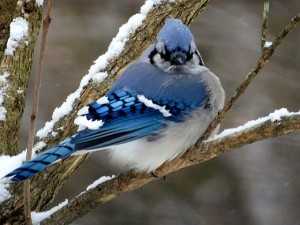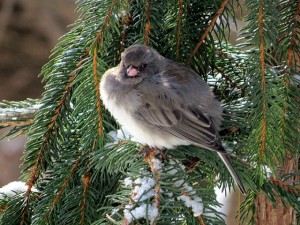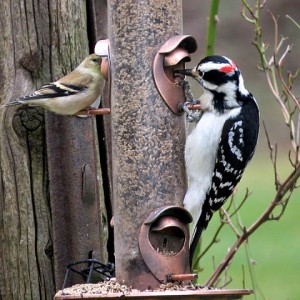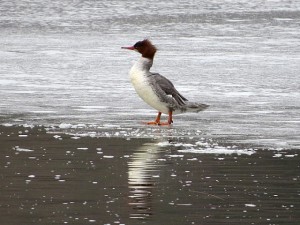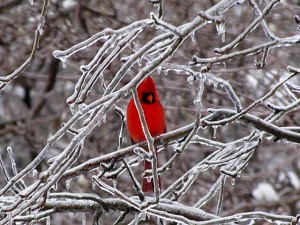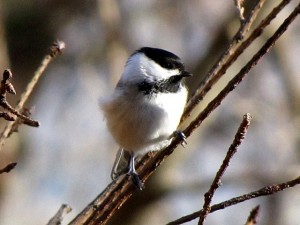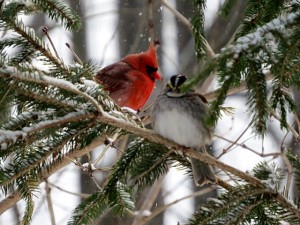Enjoy Winter! Birds of a Feather
by Tim Burris, Mariton Preserve Manager. Photos by Carole Mebus.
Last winter I wrote of a series of Blog posts that listed my tips for dressing for success during the winter. If you want to review, you can click on this Enjoy Winter! link.
This winter, I thought I would touch on adaptations used by local wildlife to survive frigid temperatures. I’ll start the series with birds. (Much thanks to Carole Mebus whose photos illustrate several of my points perfectly.) Birds have an interesting strategy for dealing with the cold. Many people think that birds migrate to escape the cold, but that isn’t completely true. Most birds migrate to find food. If you eat flying insects, finding food becomes difficult when it gets cold. So, you either change your diet, or follow your food to some place where it is warmer. On the other hand, if food is available through the winter why risk the dangers of migrating? Birds that feed on seeds, dried berries and burrowing insects can find enough calories to survive the cold winter. Here are some of the ways that they do it.
Insulation. The best sleeping bags and jackets use goose down because down provides amazing insulation. Down has lots of air spaces to trap heat. Birds “fluff” up on the coldest days to make their insulating down layer even thicker with more air spaces. To further protect from heat loss, outer feathers serve as a shell, providing a barrier to heat loss, as well as another insulation layer. The oils on outer feathers repel water and add even more insulation.
Migrating birds add fat reserves to help provide fuel over lengthy migrations. Wintering birds also add fat reserves in the fall that will provide an extra layer of insulation, and important calories in times of need.
Furnace. Birds are warm-blooded and have high metabolisms. Their hearts are more efficient than ours, and they maintain higher body temperatures. So the internal furnace runs hotter, but that means it takes more fuel to maintain. We can help by putting out foods with lots of fat calories, such as suet and oily seeds.
Circulation. Birds have a neat adaptation that allows them to restrict blood flow to their feet and legs where heat would be rapidly lost. Think about ducks standing on the ice, or a Cardinal perched on an ice-coated branch. They can reduce the volume of blood reaching those extremities by constricting arteries.
They also use a technique copied recently by home heating technology. They facilitate heat exchange by running arteries (warm blood flowing away from the heart) next to veins (cooled blood flowing back to the heart). In this way, warm arteries exchange heat to leg veins before that blood renters the body core. So, blood returning to the heart is not as cold, which reduces fuel needs in keeping blood warm.
Of course, eventually extremities in severe situations would freeze (much as we would get frost bite). So, a bird’s body can release short bursts of warm blood to keep the tissue alive. It is quite an amazing adaptation.
Torpor. It is a risky adaptation, but severe situations call for extreme measures. Many birds can temporarily lower their metabolisms and body temperatures to enter a state called torpor. It allows the bird to conserve energy at a cost of being virtually immobile during torpor. When human body temperatures drop significantly, the condition is called hypothermia. Hypothermia can be deadly for humans without medical aid. But birds can come out of torpor and raise their core temperatures back to normal when the weather improves, or food becomes available again.
Behavior. There are lots of simple things that birds (and smart people) do to conserve heat.
Get out of the wind. Whether you stand behind a tree or nestle into a spruce tree, getting out of the wind is important to retaining body heat. Grouse even bury themselves in snow banks.
Perch in the sun. There have been lots of mornings perched in a tree stand when I really appreciated the sun as it rose above the horizon. Watch birds in cold weather and you will witness them taking advantage of the sun.
Tuck. Just as we tuck cold hands under our arms for warmth, birds can insert their face or feet into the insulation of their feathers to warm their extremities.
Shiver. It is a short term solution, but in both humans and birds shivering is the body’s method of burning calories to generate heat.
Find a friend. Some birds roost together and share body heat. I have occasionally found chickadees bundled together in nest boxes during the winter. But in the absence of a cavity, birds can huddle together on a protected branch.
You can help. If you have bird feeders, keeping them full of high quality foods during the winter is important. Food is fuel for a bird’s heating system. (If you have ever run out heating oil, gas or electricity during the winter you can understand the consequences wildlife running out of food.) Shoveling patches of snow under feeders and around the yard can also expose food for foraging birds.
Providing habitat around your feeding area is also important. Planting food producing shrubs in your yard is a good start. I also place unsold Christmas trees around the bird blind to provide shelter (from both weather and predators). They lose their needles in the spring, but still provide safe perches until the following December 26th. Put out roosting shelters where birds can snuggle together during bad weather or a cold night. These can be as simple as a bird box, a shelf under your house’ s eaves, or a hollow log protected from predators.
Birds delight us with their flight, colors, and songs. The winter is hard for them too, but how they deal with the weather makes them even more amazing to bird watchers.
Sources: The Sibley Guide to Bird Life & Behavior, Melissa Mayntz, Cornell Lab of Ornithology

